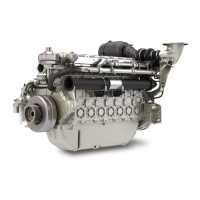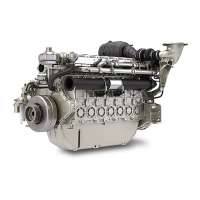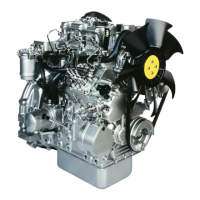Do you have a question about the Perkins 4008-30 and is the answer not in the manual?
Warning about chemicals known to cause cancer, birth defects, and reproductive harm.
Information on manual content, storage, and language.
Details on warning signs, their location, and maintenance.
Instructions to read manual warnings; location of universal warning labels.
Warning about not stepping on certain surfaces due to slipperiness or instability.
Warning about hot parts causing burns; use protective clothing.
Warning about hot coolant under pressure causing burns; procedure for opening cap.
Warning against using aerosol starting aids due to explosion risk.
Warning about rotating shafts causing injury or death; keep hands away.
Warning about pressurized fluid injection causing injury or death.
Precautions for containing fluids during service and proper disposal.
Handling precautions for hexavalent chromium on exhaust systems.
Handling guidelines for asbestos debris and asbestos-free parts.
Warning about hot coolant under pressure causing burns.
Warning about hot oil causing burns.
Warning about burning Viton seals producing hazardous acid.
Procedures for starting the engine safely and correctly.
Procedures for stopping the engine safely and correctly.
Importance of proper grounding for engine electrical system reliability.
Illustrative views of engine features for specific models.
Details on engine front/rear, left/right sides, and cylinder numbering.
Components of the cooling and lubrication systems.
Factors affecting engine service life and utilization.
Location of the engine serial number plate and emission label.
Instructions for safely lifting the specified engine models.
Instructions for safely lifting the radiator.
Storage level for 12 months, used for transport in container or truck.
Storage level for 2 years under normal conditions (-15° to +55°C, 90% humidity).
Storage level for 5 years in tropical/arctic climates or specific European standards.
Engine sensors and switches monitoring key parameters like temperature and pressure.
Typical locations of sensors and electrical components on the engine.
How Perkins engines perform self-diagnostics and retrieve codes.
Function of the diagnostic lamp to indicate active faults.
Capability of logging diagnostic codes and identifying them with a service tool.
How to interpret active diagnostic codes during normal engine operation.
How to handle intermittent faults and log observations.
Parameters affecting emissions/power, programmed at factory.
Parameters configurable for specific application needs.
Critical checks and steps to perform before starting the engine.
Step-by-step guide for normal engine starting.
Procedure for new or rebuilt engines and after major overhaul.
Procedure for standby applications or engines with low hours.
Tips for saving fuel and maximizing engine efficiency.
General guidelines for stopping the engine.
Use of emergency stop button and its function.
Checks and actions to perform after the engine has been stopped.
Refill capacities for the engine crankcase and oil filters.
Refill capacities for the cooling system with and without radiator.
Important notices and reasons for cleaning the cooling system.
Recommendations for using distilled/deionized water and types to avoid.
Recommended coolant types (ELC, ELI) and commercial alternatives.
Information on API, SAE, ECF standards and licensing.
Preferred and acceptable Perkins diesel engine oils and their specifications.
Recommended oil viscosity grades for different ambient temperatures.
Information on fuel quality, water in fuel, and general advice.
Information on preferred and permissible diesel fuels.
Perkins' stance on aftermarket fuel additives and precautions.
Maintenance tasks based on hours/time for base load applications.
Maintenance tasks based on hours/time for standby applications.
Maintenance tasks based on hours/time for prime power applications.
Procedure for cleaning and testing the aftercooler core.
Procedure for inspecting the aftercooler core for damage and debris.
Procedure for inspecting the alternator and checking battery charging.
Procedure for checking the alternator pulley and tightening grub screws.
Procedure for safely replacing the engine battery.
Procedure for checking and maintaining battery electrolyte level.
Procedure for safely disconnecting battery cables or batteries.
How to inspect and adjust fan drive belts for correct tension.
Procedure for replacing fan drive belts.
How to inspect and adjust belts for the 4006-23 engine.
Procedure for inspecting, adjusting, and replacing the alternator belt.
Procedure for changing Extended Life Coolant (ELC).
Procedure for checking the engine coolant level.
Procedure for replacing the engine air cleaner element.
Procedure for checking and resetting the air cleaner service indicator.
Procedure for cleaning the breather on the 4006-23 engine.
Procedure for cleaning the breather on the 4008-30 engine.
Steps for starting an oil analysis program.
How to properly take an oil sample and record information.
Procedure for replacing the engine oil filters.
Procedure for filling the engine oil pan with new oil.
Factors determining the need for a major overhaul.
Factors determining the need for a top end overhaul.
How to monitor valve seat wear and record valve lash.
Information on emissions warranty coverage.
Warning about chemicals known to cause cancer, birth defects, and reproductive harm.
Information on manual content, storage, and language.
Details on warning signs, their location, and maintenance.
Instructions to read manual warnings; location of universal warning labels.
Warning about not stepping on certain surfaces due to slipperiness or instability.
Warning about hot parts causing burns; use protective clothing.
Warning about hot coolant under pressure causing burns; procedure for opening cap.
Warning against using aerosol starting aids due to explosion risk.
Warning about rotating shafts causing injury or death; keep hands away.
Warning about pressurized fluid injection causing injury or death.
Precautions for containing fluids during service and proper disposal.
Handling precautions for hexavalent chromium on exhaust systems.
Handling guidelines for asbestos debris and asbestos-free parts.
Warning about hot coolant under pressure causing burns.
Warning about hot oil causing burns.
Warning about burning Viton seals producing hazardous acid.
Procedures for starting the engine safely and correctly.
Procedures for stopping the engine safely and correctly.
Importance of proper grounding for engine electrical system reliability.
Illustrative views of engine features for specific models.
Details on engine front/rear, left/right sides, and cylinder numbering.
Components of the cooling and lubrication systems.
Factors affecting engine service life and utilization.
Location of the engine serial number plate and emission label.
Instructions for safely lifting the specified engine models.
Instructions for safely lifting the radiator.
Storage level for 12 months, used for transport in container or truck.
Storage level for 2 years under normal conditions (-15° to +55°C, 90% humidity).
Storage level for 5 years in tropical/arctic climates or specific European standards.
Engine sensors and switches monitoring key parameters like temperature and pressure.
Typical locations of sensors and electrical components on the engine.
How Perkins engines perform self-diagnostics and retrieve codes.
Function of the diagnostic lamp to indicate active faults.
Capability of logging diagnostic codes and identifying them with a service tool.
How to interpret active diagnostic codes during normal engine operation.
How to handle intermittent faults and log observations.
Parameters affecting emissions/power, programmed at factory.
Parameters configurable for specific application needs.
Critical checks and steps to perform before starting the engine.
Step-by-step guide for normal engine starting.
Procedure for new or rebuilt engines and after major overhaul.
Procedure for standby applications or engines with low hours.
Tips for saving fuel and maximizing engine efficiency.
General guidelines for stopping the engine.
Use of emergency stop button and its function.
Checks and actions to perform after the engine has been stopped.
Refill capacities for the engine crankcase and oil filters.
Refill capacities for the cooling system with and without radiator.
Important notices and reasons for cleaning the cooling system.
Recommendations for using distilled/deionized water and types to avoid.
Recommended coolant types (ELC, ELI) and commercial alternatives.
Information on API, SAE, ECF standards and licensing.
Preferred and acceptable Perkins diesel engine oils and their specifications.
Recommended oil viscosity grades for different ambient temperatures.
Information on fuel quality, water in fuel, and general advice.
Information on preferred and permissible diesel fuels.
Perkins' stance on aftermarket fuel additives and precautions.
Maintenance tasks based on hours/time for base load applications.
Maintenance tasks based on hours/time for standby applications.
Maintenance tasks based on hours/time for prime power applications.
Procedure for cleaning and testing the aftercooler core.
Procedure for inspecting the aftercooler core for damage and debris.
Procedure for inspecting the alternator and checking battery charging.
Procedure for checking the alternator pulley and tightening grub screws.
Procedure for safely replacing the engine battery.
Procedure for checking and maintaining battery electrolyte level.
Procedure for safely disconnecting battery cables or batteries.
How to inspect and adjust fan drive belts for correct tension.
Procedure for replacing fan drive belts.
How to inspect and adjust belts for the 4006-23 engine.
Procedure for inspecting, adjusting, and replacing the alternator belt.
Procedure for changing Extended Life Coolant (ELC).
Procedure for checking the engine coolant level.
Procedure for replacing the engine air cleaner element.
Procedure for checking and resetting the air cleaner service indicator.
Procedure for cleaning the breather on the 4006-23 engine.
Procedure for cleaning the breather on the 4008-30 engine.
Steps for starting an oil analysis program.
How to properly take an oil sample and record information.
Procedure for replacing the engine oil filters.
Procedure for filling the engine oil pan with new oil.
Factors determining the need for a major overhaul.
Factors determining the need for a top end overhaul.
How to monitor valve seat wear and record valve lash.
Information on emissions warranty coverage.
| Engine Model | 4008-30 |
|---|---|
| Engine Type | Diesel |
| Cylinders | 8 |
| Aspiration | Turbocharged |
| Cooling System | Water-cooled |
| Displacement | 30.5 liters (1861 cubic inches) |











